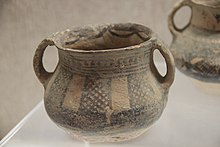
Back علم آثار ما قبل التاريخ Arabic Праисторическа археология Bulgarian Pravěká archeologie Czech Forhistorisk arkæologi Danish Προϊστορική αρχαιολογία Greek Prahistoria arkeologio Esperanto Arqueología prehistórica Spanish Esihistoriallinen arkeologia Finnish Préhistoire (discipline) French Arkeologi prasejarah ID
This article needs additional citations for verification. (February 2015) |
Prehistoric archaeology is a subfield of archaeology,[1] which deals specifically with artefacts, civilisations and other materials from societies that existed before any form of writing system or historical record. Often the field focuses on ages such as the Stone Age, Bronze Age and Iron Age, although it also encompasses periods such as the Neolithic. The study of prehistoric archaeology reflects the cultural concerns of modern society by showing interpretations of time between economic growth and political stability.[2] It is related to other disciplines such as geology, biology, anthropology, historiography and palaeontology, although there are noticeable differences between the subjects they all broadly study to understand; the past, either organic or inorganic or the lives of humans.[2] Prehistoric archaeology is also sometimes termed as anthropological archaeology because of its indirect traces with complex patterns.[2]

Due to the unique nature of prehistoric archaeology, in that written records can not be drawn upon to aid the study of the societies it focuses on, the subject matter investigated is entirely material remains as they are the only traceable evidence that is available. Material evidence includes pottery, burial goods, the remains of individuals and animals such as bones, jewellery and decorative items as well as many other artefacts. The subfield has existed since at least the late 1820s or early 1830s [3] and is now a fully recognised and separate field of archaeology. Other fields of archaeology include; Classical archaeology, Near Eastern archaeology - as known as Biblical archaeology, Historical archaeology, Underwater archaeology and many more, each working to reconstruct our understanding of everything from the ancient past right up until modern times. Unlike continent and area specific fields of archaeology such as; Classical - which studies specifically the Mediterranean region and the civilisations of Ancient Greece and Ancient Rome in antiquity, the field of prehistoric archaeology is not contained to one continent. As such, there are many excavations attributed to this field which have occurred and are occurring all over the world to uncover all different types of settlements and civilisations.
Without history to provide evidence for names, places and motivations, prehistoric archaeologists speak in terms of cultures which can only be given arbitrary modern names relating to the locations of known occupation sites or the artifacts used. It is naturally much easier to discuss societies rather than individuals as these past people are completely anonymous in the archaeological record. Such a lack of concrete information means that prehistoric archaeology is a contentious field and the arguments that range over it have done much to inform archaeological theory.[4]
- ^ "Archaeology Defined". Institute for Field Research. Retrieved 30 March 2022.
- ^ a b c Fagan, Brian M. (1996). The Oxford Companion to Archaeology (1st ed.). Oxford University Press. doi:10.1093/acref/9780195076189.001.0001. ISBN 9780199891085. OCLC 35178577.
- ^ Chippindale, Christopher (1988), "The Invention of Words for the Idea of 'Prehistory'", Proceedings of the Prehistoric Society, 54: 303–313, doi:10.1017/S0079497X00005867
- ^ Murray, Tim (17 June 2013). "Why the history of archaeology is essential to theoretical archaeology" (PDF). Complutum. 24 (2). Universidad Complutense de Madrid: 21–31. doi:10.5209/rev_CMPL.2013.v24.n2.43364. ISSN 1131-6993. Retrieved 2 October 2018.
© MMXXIII Rich X Search. We shall prevail. All rights reserved. Rich X Search